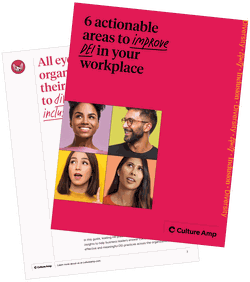
Article

Written by

Former Head of Diversity & Inclusion
In 2015, Culture Amp and Paradigm developed the Diversity & Inclusion Survey. It was an open-source collaboration designed to be the gold standard for measuring employee experience across seven diversity and inclusion factors. While measuring representation is undoubtedly the first place that organizations start, the most inclusive companies have evolved into measuring the employee experience between different demographic groups.
Representation is a measure of diversity. The employee experience is a measure of inclusion.
Over a hundred companies in North America, Asia, and Europe have gathered diversity, equity, and inclusion feedback through the Culture Amp platform. We applaud these organizations for taking a bold step - but we accept that not every organization is ready for a deep dive.
Many organizations are just starting their DEI journey, and here at Culture Amp, we want to meet you where you’re at. To that end, we’re sharing the five most insightful questions from our DEI Survey that you should consider integrating into your engagement survey – and why:
As we started collecting tens of thousands of survey responses from the D&I Survey template, one thing became clear: belonging matters. Belonging consistently shows up as a high driver for engagement in our global DEI benchmark across all industries and sizes; this means that belonging has a high correlation to business outcomes like productivity and retention.
The benchmark score for this question is 80%. That is, 80% of your workforce should agree or strongly agree with this question. But, most importantly, you want to minimize the difference between demographic groups. Pay special attention to Women of Color and LGBTQ women, as they often score 10-15% lower than the highest-scoring group (Straight White Men).
Diverse and balanced teams produce better results, but how? When members from different backgrounds share their opinions in a healthy debate, the best option to move forward is chosen. If you have a diverse team, but team members are afraid to voice a contrary opinion – then all that work to create diversity will not produce the results you intended. Diversity works if all team members can share their opinion without fear of negative consequences.
The benchmark score for this question is 70%. But again – pay special attention to groups that are numerically underrepresented or face stereotypic threats in organizations – those challenges make it harder to speak up. This visualization from our 2018 Diversity, Inclusion, and Intersectionality Report shows the favorability scores within our global benchmark. While 78% of White Men feel they can voice a contrary opinion, only 56% of Black Women agree with this statement:
Most leadership teams do not represent the employee base completely, particularly regarding visible diversity like gender and race/ethnicity. However, as long as employees feel that perspectives like theirs are included in decision-making, they will likely feel a strong sense of inclusion. When decisions are made with the support of underrepresented people, a stronger sense of inclusion will result in higher engagement and retention.
The benchmark score for this question is 60%. However, massive differences between demographic groups can work against your efforts to create an inclusive culture. When seeking to make important decisions, make sure to leverage the voices and perspectives of a diverse group, ideally, one that matches the customers you serve.
If you want to retain all types of talent, you’ll want to communicate a Growth Mindset to employees. You need to let them know that you believe they have the ability and potential to grow, not that their skills are forever fixed at their current level. This question was adapted from Carol Dweck’s research on the growth mindset and has proved to be a compelling question for determining a company’s growth mindset.
The benchmark score for this question is 82%. If you want to improve your score in this construct, consider what messages you are communicating to your employees about performance and feedback. Have you de-coupled performance conversations from feedback/development? How frequent are your feedback cycles? Evaluate these practices if you score below the benchmark.
Part of an inclusive culture is minimizing microaggressions - but any question that directly asks about “microaggressions” verbatim is going to trigger your respondents. Rather than ask directly about microaggressions, this question asks something personally relevant and easy to search your memory for a response as administrative tasks are part of daily work. It’s also a question that is immediately actionable.
The benchmark score is low on this one: 56%. If you’re thinking, “only 56%? We would score higher than that!” – I encourage you to include this in your next engagement survey. The results might surprise you!
Demographic representation is an essential metric that every company should collect, not only for compliance purposes but to understand the extent to which an organization’s collective lived experiences are shared by the communities in which they work and serve.
Demographic representation, however, is an incomplete DEI metric. Simply counting the number of women and underrepresented minorities does not ensure an inclusive experience; comparing the favorability scores between intersectional groups is a better way to measure organizational equity.
Your engagement survey allows every employee to confidentially share their sentiments regarding their own employee experience. Consider implementing these questions in your next engagement survey.
